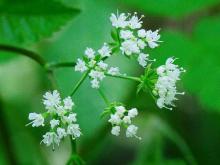Wildflowers, Grasses and Other Nonwoody Plants
Media

Species Types
Scientific Name
Viola pubescens (formerly V. pensylvanica)
Description
The yellow violet is Missouri's only all-yellow violet. This native wildflower is less common than violet violets. Look for it in low woods, rich slopes, and wooded floodplains.
Media

Species Types
Scientific Name
Allium stellatum
Description
Wild onion is edible and is also favored by native-plant gardeners, who enjoy its showy umbels of pink flowers and tolerance of dry, rocky sites. This Ozark species blooms in summer and fall.
Media

Species Types
Scientific Name
Camassia scilloides
Description
In spring, wild hyacinth bears an elongated cluster of pale blue flowers with prominent anthers that sway on stalks up to 2 feet tall.
Media

Species Types
Scientific Name
Podophyllum peltatum
Description
Mayapple is a common spring wildflower that makes its biggest impression with its leaves, which resemble umbrellas arising from a single stalk. It often grows in colonies.
Media

Species Types
Scientific Name
Cirsium vulgare
Description
Bull thistle is a weedy introduction from Europe, found statewide. To tell it from our other thistles, note its stems with spiny-margined wings, and its leaves with the upper surface strongly roughened with stiff, spiny bristles.
Media

Species Types
Scientific Name
Cirsium altissimum
Description
Tall thistle is a native thistle that can grow to be 10 feet tall! To identify it, notice its leaves, which are unlobed (though they may be wavy or have only shallow, broad lobes), are felty-hairy beneath, and have prickles only along the edges.
Media

Species Types
Scientific Name
Fragaria virginiana
Description
Wild strawberry is one of the parents of the cultivated strawberry and is one of our prized native wild edibles. It’s also a valuable food for innumerable animals, and it’s attractive in native wildflower gardens.
Media

Species Types
Scientific Name
Yucca smalliana, Y. glauca, and Y. arkansana
Description
Three species of yucca grow wild in Missouri. Spanish bayonet was introduced from the Southwest and has escaped from cultivation, but our two soapweeds are native.
Media

Species Types
Scientific Name
Osmorhiza claytonii and O. longistylis
Description
Missouri has two species of sweet cicely, which can be hard to tell apart. Both have umbels of small white flowers, fernlike leaves, and sweetly aromatic, carrotlike roots.
Media

Species Types
Scientific Name
Viola spp.
Description
Violets, as a group, are fairly easy to identify, with their colorful five-petaled “faces” so welcome in springtime. Missouri has 17 species, and some are confusingly similar. This page introduces them as a group.
See Also
About Wildflowers, Grasses and Other Nonwoody Plants in Missouri
A very simple way of thinking about the green world is to divide the vascular plants into two groups: woody and nonwoody (or herbaceous). But this is an artificial division; many plant families include some species that are woody and some that are not. The diversity of nonwoody vascular plants is staggering! Think of all the ferns, grasses, sedges, lilies, peas, sunflowers, nightshades, milkweeds, mustards, mints, and mallows — weeds and wildflowers — and many more!





















